Software Testing
VerifiedAdded on 2023/04/21
|8
|1409
|125
AI Summary
This document provides a comprehensive test plan for software testing of a cloud-based personal insulin pump. It covers the purpose, scope, background, test items, risk issues, features to be tested, approach, pass/fail criteria, and more.
Contribute Materials
Your contribution can guide someone’s learning journey. Share your
documents today.

qwertyuiopasdfghjklzxcvbnmqw
ertyuiopasdfghjklzxcvbnmqwert
yuiopasdfghjklzxcvbnmqwertyui
opasdfghjklzxcvbnmqwertyuiop
asdfghjklzxcvbnmqwertyuiopasd
fghjklzxcvbnmqwertyuiopasdfgh
jklzxcvbnmqwertyuiopasdfghjkl
zxcvbnmqwertyuiopasdfghjklzxc
vbnmqwertyuiopasdfghjklzxcvb
nmqwertyuiopasdfghjklzxcvbnm
qwertyuiopasdfghjklzxcvbnmqw
ertyuiopasdfghjklzxcvbnmqwert
yuiopasdfghjklzxcvbnmqwertyui
opasdfghjklzxcvbnmqwertyuiop
asdfghjklzxcvbnmqwertyuiopasd
fghjklzxcvbnmqwertyuiopasdfgh
jklzxcvbnmrtyuiopasdfghjklzxcv
Software Testing
Cloud-based Personal Insulin Pump
1/1/2019
ertyuiopasdfghjklzxcvbnmqwert
yuiopasdfghjklzxcvbnmqwertyui
opasdfghjklzxcvbnmqwertyuiop
asdfghjklzxcvbnmqwertyuiopasd
fghjklzxcvbnmqwertyuiopasdfgh
jklzxcvbnmqwertyuiopasdfghjkl
zxcvbnmqwertyuiopasdfghjklzxc
vbnmqwertyuiopasdfghjklzxcvb
nmqwertyuiopasdfghjklzxcvbnm
qwertyuiopasdfghjklzxcvbnmqw
ertyuiopasdfghjklzxcvbnmqwert
yuiopasdfghjklzxcvbnmqwertyui
opasdfghjklzxcvbnmqwertyuiop
asdfghjklzxcvbnmqwertyuiopasd
fghjklzxcvbnmqwertyuiopasdfgh
jklzxcvbnmrtyuiopasdfghjklzxcv
Software Testing
Cloud-based Personal Insulin Pump
1/1/2019
Secure Best Marks with AI Grader
Need help grading? Try our AI Grader for instant feedback on your assignments.
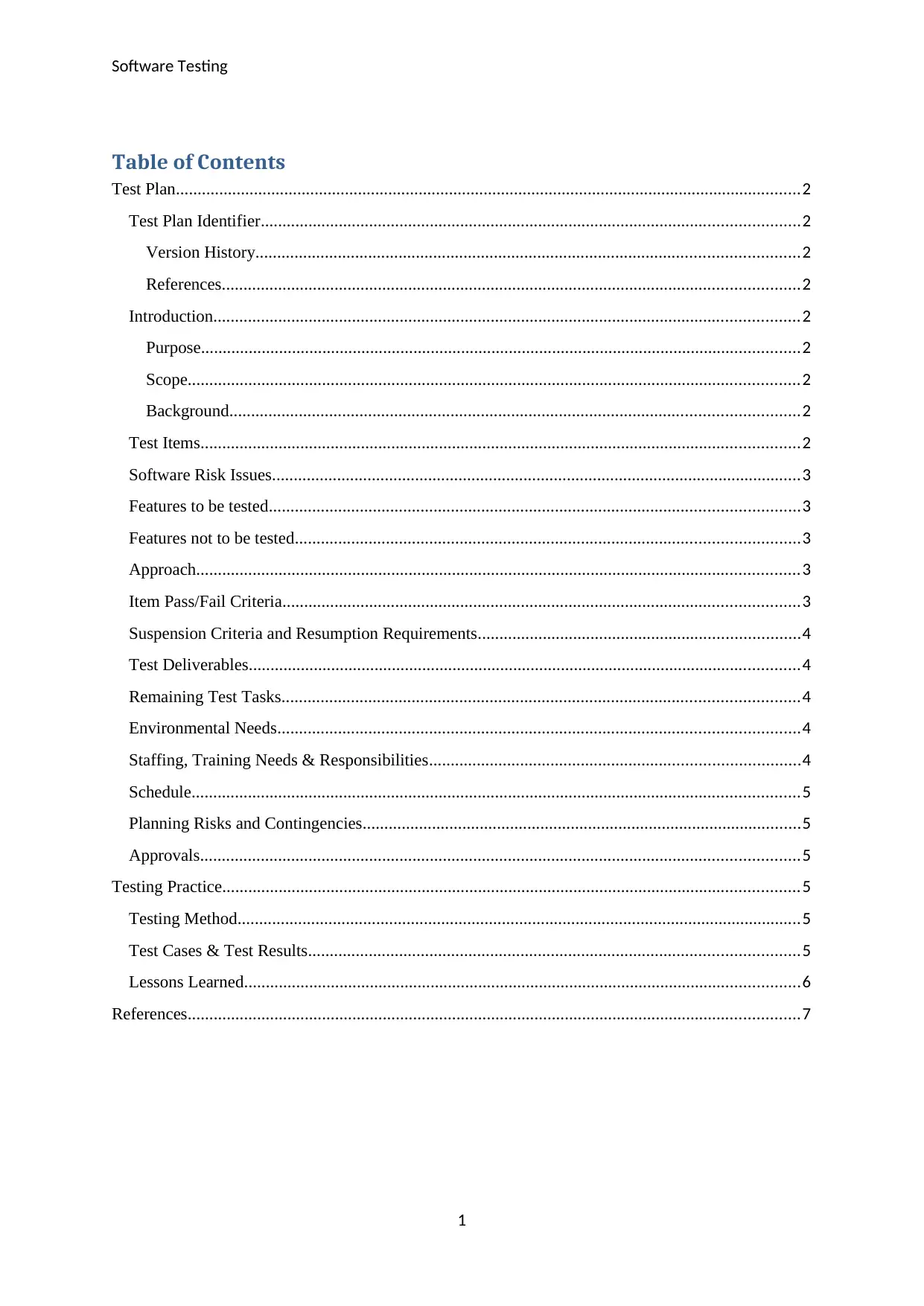
Software Testing
Table of Contents
Test Plan................................................................................................................................................2
Test Plan Identifier............................................................................................................................2
Version History.............................................................................................................................2
References.....................................................................................................................................2
Introduction.......................................................................................................................................2
Purpose..........................................................................................................................................2
Scope.............................................................................................................................................2
Background...................................................................................................................................2
Test Items..........................................................................................................................................2
Software Risk Issues..........................................................................................................................3
Features to be tested..........................................................................................................................3
Features not to be tested....................................................................................................................3
Approach...........................................................................................................................................3
Item Pass/Fail Criteria.......................................................................................................................3
Suspension Criteria and Resumption Requirements..........................................................................4
Test Deliverables...............................................................................................................................4
Remaining Test Tasks.......................................................................................................................4
Environmental Needs........................................................................................................................4
Staffing, Training Needs & Responsibilities.....................................................................................4
Schedule............................................................................................................................................5
Planning Risks and Contingencies.....................................................................................................5
Approvals..........................................................................................................................................5
Testing Practice.....................................................................................................................................5
Testing Method..................................................................................................................................5
Test Cases & Test Results.................................................................................................................5
Lessons Learned................................................................................................................................6
References.............................................................................................................................................7
1
Table of Contents
Test Plan................................................................................................................................................2
Test Plan Identifier............................................................................................................................2
Version History.............................................................................................................................2
References.....................................................................................................................................2
Introduction.......................................................................................................................................2
Purpose..........................................................................................................................................2
Scope.............................................................................................................................................2
Background...................................................................................................................................2
Test Items..........................................................................................................................................2
Software Risk Issues..........................................................................................................................3
Features to be tested..........................................................................................................................3
Features not to be tested....................................................................................................................3
Approach...........................................................................................................................................3
Item Pass/Fail Criteria.......................................................................................................................3
Suspension Criteria and Resumption Requirements..........................................................................4
Test Deliverables...............................................................................................................................4
Remaining Test Tasks.......................................................................................................................4
Environmental Needs........................................................................................................................4
Staffing, Training Needs & Responsibilities.....................................................................................4
Schedule............................................................................................................................................5
Planning Risks and Contingencies.....................................................................................................5
Approvals..........................................................................................................................................5
Testing Practice.....................................................................................................................................5
Testing Method..................................................................................................................................5
Test Cases & Test Results.................................................................................................................5
Lessons Learned................................................................................................................................6
References.............................................................................................................................................7
1
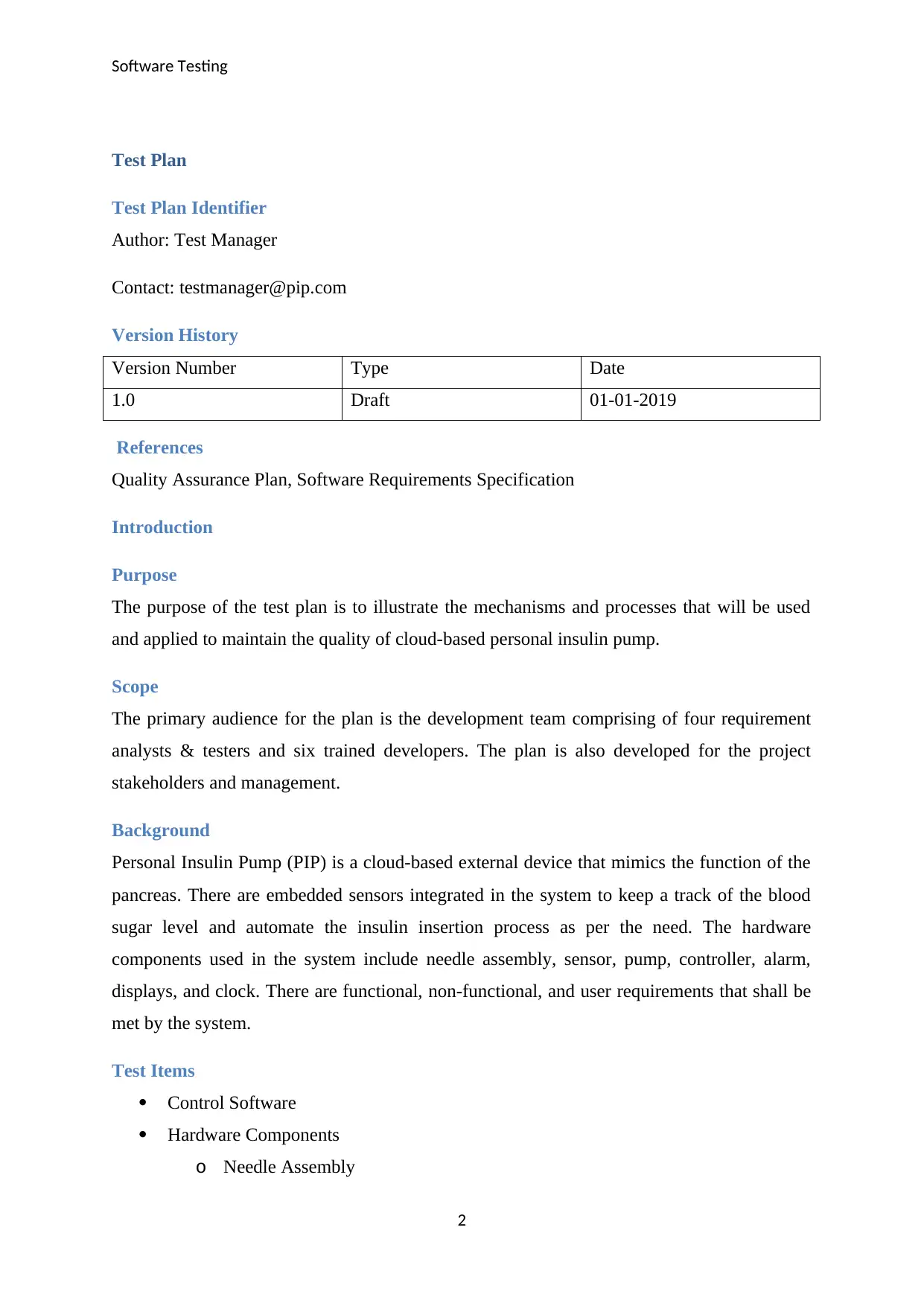
Software Testing
Test Plan
Test Plan Identifier
Author: Test Manager
Contact: testmanager@pip.com
Version History
Version Number Type Date
1.0 Draft 01-01-2019
References
Quality Assurance Plan, Software Requirements Specification
Introduction
Purpose
The purpose of the test plan is to illustrate the mechanisms and processes that will be used
and applied to maintain the quality of cloud-based personal insulin pump.
Scope
The primary audience for the plan is the development team comprising of four requirement
analysts & testers and six trained developers. The plan is also developed for the project
stakeholders and management.
Background
Personal Insulin Pump (PIP) is a cloud-based external device that mimics the function of the
pancreas. There are embedded sensors integrated in the system to keep a track of the blood
sugar level and automate the insulin insertion process as per the need. The hardware
components used in the system include needle assembly, sensor, pump, controller, alarm,
displays, and clock. There are functional, non-functional, and user requirements that shall be
met by the system.
Test Items
Control Software
Hardware Components
o Needle Assembly
2
Test Plan
Test Plan Identifier
Author: Test Manager
Contact: testmanager@pip.com
Version History
Version Number Type Date
1.0 Draft 01-01-2019
References
Quality Assurance Plan, Software Requirements Specification
Introduction
Purpose
The purpose of the test plan is to illustrate the mechanisms and processes that will be used
and applied to maintain the quality of cloud-based personal insulin pump.
Scope
The primary audience for the plan is the development team comprising of four requirement
analysts & testers and six trained developers. The plan is also developed for the project
stakeholders and management.
Background
Personal Insulin Pump (PIP) is a cloud-based external device that mimics the function of the
pancreas. There are embedded sensors integrated in the system to keep a track of the blood
sugar level and automate the insulin insertion process as per the need. The hardware
components used in the system include needle assembly, sensor, pump, controller, alarm,
displays, and clock. There are functional, non-functional, and user requirements that shall be
met by the system.
Test Items
Control Software
Hardware Components
o Needle Assembly
2

Software Testing
o Sensor
o Pump
o Controller
o Alarm
o Displays
o Clock
Software Risk Issues
Information Security Attacks – Malware Attacks, Data Breaches, Flooding Attacks,
Injection Attacks, and Data Leakage.
Violation of Legal/Security/Ethical Standard
Features to be tested
Start-up of the insulin pump (Risk Level: Medium)
Resetting of the Pump (Risk Level: Medium)
Execution of self-test (Risk Level: High) (Ieee, 2019)
Normal run (Risk Level: Medium)
Manual run & out of action (Risk Level: High)
Integration of the hardware components (Risk Level: Low)
Compatibility Testing
Features not to be tested
Syncing of the device with other healthcare devices and equipment
Approach
The testing types that will be used to test the above features will be unit testing, integration
testing, system testing, performance testing, regression testing, sanity testing, and security
testing.
The testing tools used to carry out the testing will be HP Quality Centre, Selenium, and
Bugzilla.
The quality metrics used to measure the results will be defect density, defect rate, mean time
to failure, and downtime of the system.
3
o Sensor
o Pump
o Controller
o Alarm
o Displays
o Clock
Software Risk Issues
Information Security Attacks – Malware Attacks, Data Breaches, Flooding Attacks,
Injection Attacks, and Data Leakage.
Violation of Legal/Security/Ethical Standard
Features to be tested
Start-up of the insulin pump (Risk Level: Medium)
Resetting of the Pump (Risk Level: Medium)
Execution of self-test (Risk Level: High) (Ieee, 2019)
Normal run (Risk Level: Medium)
Manual run & out of action (Risk Level: High)
Integration of the hardware components (Risk Level: Low)
Compatibility Testing
Features not to be tested
Syncing of the device with other healthcare devices and equipment
Approach
The testing types that will be used to test the above features will be unit testing, integration
testing, system testing, performance testing, regression testing, sanity testing, and security
testing.
The testing tools used to carry out the testing will be HP Quality Centre, Selenium, and
Bugzilla.
The quality metrics used to measure the results will be defect density, defect rate, mean time
to failure, and downtime of the system.
3
Secure Best Marks with AI Grader
Need help grading? Try our AI Grader for instant feedback on your assignments.
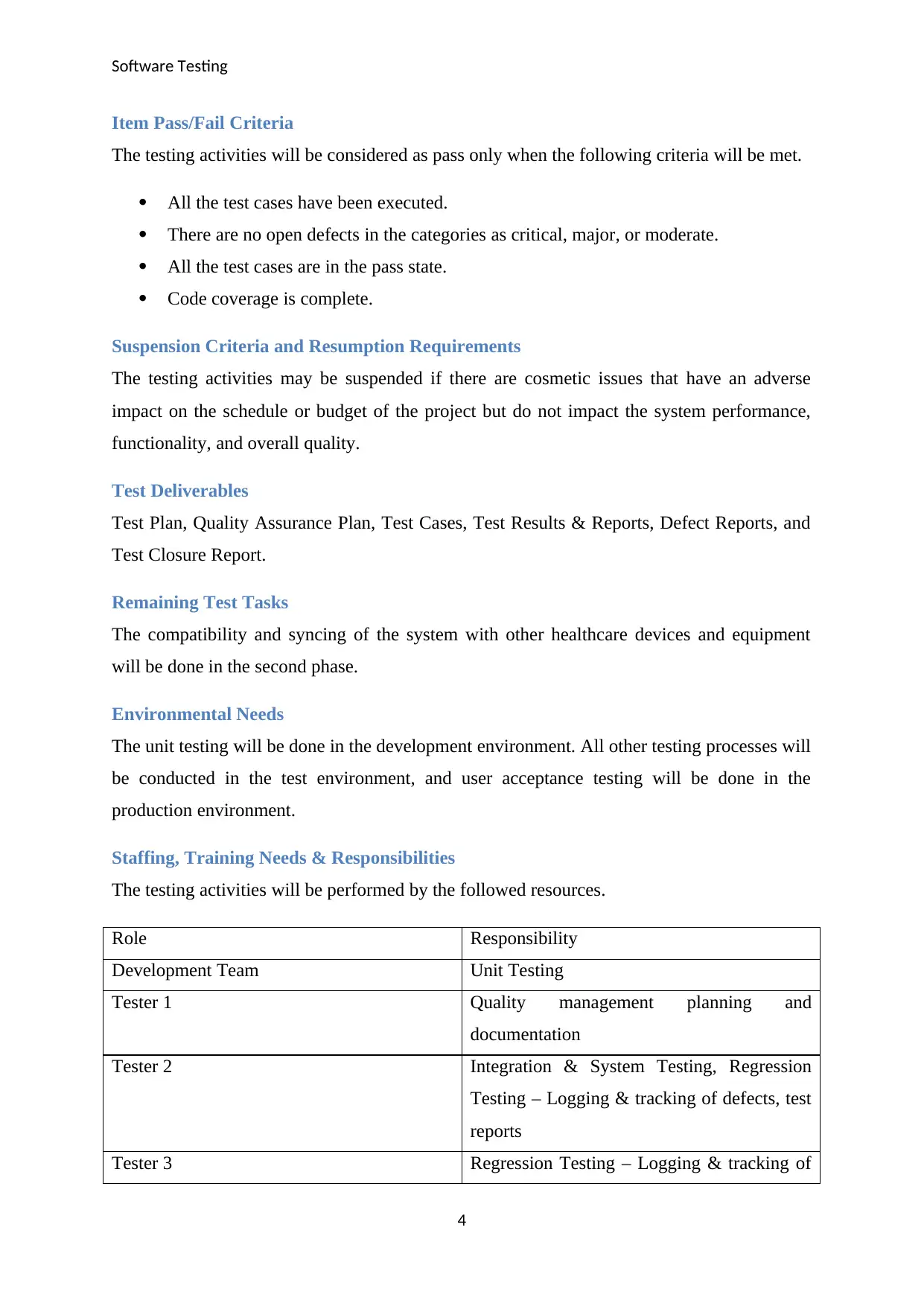
Software Testing
Item Pass/Fail Criteria
The testing activities will be considered as pass only when the following criteria will be met.
All the test cases have been executed.
There are no open defects in the categories as critical, major, or moderate.
All the test cases are in the pass state.
Code coverage is complete.
Suspension Criteria and Resumption Requirements
The testing activities may be suspended if there are cosmetic issues that have an adverse
impact on the schedule or budget of the project but do not impact the system performance,
functionality, and overall quality.
Test Deliverables
Test Plan, Quality Assurance Plan, Test Cases, Test Results & Reports, Defect Reports, and
Test Closure Report.
Remaining Test Tasks
The compatibility and syncing of the system with other healthcare devices and equipment
will be done in the second phase.
Environmental Needs
The unit testing will be done in the development environment. All other testing processes will
be conducted in the test environment, and user acceptance testing will be done in the
production environment.
Staffing, Training Needs & Responsibilities
The testing activities will be performed by the followed resources.
Role Responsibility
Development Team Unit Testing
Tester 1 Quality management planning and
documentation
Tester 2 Integration & System Testing, Regression
Testing – Logging & tracking of defects, test
reports
Tester 3 Regression Testing – Logging & tracking of
4
Item Pass/Fail Criteria
The testing activities will be considered as pass only when the following criteria will be met.
All the test cases have been executed.
There are no open defects in the categories as critical, major, or moderate.
All the test cases are in the pass state.
Code coverage is complete.
Suspension Criteria and Resumption Requirements
The testing activities may be suspended if there are cosmetic issues that have an adverse
impact on the schedule or budget of the project but do not impact the system performance,
functionality, and overall quality.
Test Deliverables
Test Plan, Quality Assurance Plan, Test Cases, Test Results & Reports, Defect Reports, and
Test Closure Report.
Remaining Test Tasks
The compatibility and syncing of the system with other healthcare devices and equipment
will be done in the second phase.
Environmental Needs
The unit testing will be done in the development environment. All other testing processes will
be conducted in the test environment, and user acceptance testing will be done in the
production environment.
Staffing, Training Needs & Responsibilities
The testing activities will be performed by the followed resources.
Role Responsibility
Development Team Unit Testing
Tester 1 Quality management planning and
documentation
Tester 2 Integration & System Testing, Regression
Testing – Logging & tracking of defects, test
reports
Tester 3 Regression Testing – Logging & tracking of
4

Software Testing
defects, Security testing, test reports
Tester 4 Regression Testing – Logging & tracking of
defects, performance testing, sanity testing,
test reports
Schedule
There will be a total of 65 days needed to carry out all the testing activities. The entire
process will be done in the phases as planning, execution, control, and closure.
Planning Risks and Contingencies
The risks associated with the testing processes will be handled using Project Management
Body of Knowledge as the risk handling approach.
Approvals
To be Approved By: Senior Manager
Testing Practice
Testing Method
Black Box testing method will be used to test the control software and hardware components
as it covers a wide range of testing activities apt for the features to be tested. Junit is followed
as the testing method as it majorly focuses on the unit testing only and will not cover the
other aspects of the system (Bonifacio & Moura, 2017).
Black box testing will assist in achieving the testing and quality goals and objectives for the
project.
Test Cases & Test Results
Test Case ID Test Case Result
1 Ability to start the insulin pump Pass
2 Ability to reset the pump Pass
3 Ability to execute a self-test using the pump Pass
4 Ability to use carry out the normal run for
the insulin pump
Pass
5 Ability to use the pump in the manual mode Pass
5
defects, Security testing, test reports
Tester 4 Regression Testing – Logging & tracking of
defects, performance testing, sanity testing,
test reports
Schedule
There will be a total of 65 days needed to carry out all the testing activities. The entire
process will be done in the phases as planning, execution, control, and closure.
Planning Risks and Contingencies
The risks associated with the testing processes will be handled using Project Management
Body of Knowledge as the risk handling approach.
Approvals
To be Approved By: Senior Manager
Testing Practice
Testing Method
Black Box testing method will be used to test the control software and hardware components
as it covers a wide range of testing activities apt for the features to be tested. Junit is followed
as the testing method as it majorly focuses on the unit testing only and will not cover the
other aspects of the system (Bonifacio & Moura, 2017).
Black box testing will assist in achieving the testing and quality goals and objectives for the
project.
Test Cases & Test Results
Test Case ID Test Case Result
1 Ability to start the insulin pump Pass
2 Ability to reset the pump Pass
3 Ability to execute a self-test using the pump Pass
4 Ability to use carry out the normal run for
the insulin pump
Pass
5 Ability to use the pump in the manual mode Pass
5
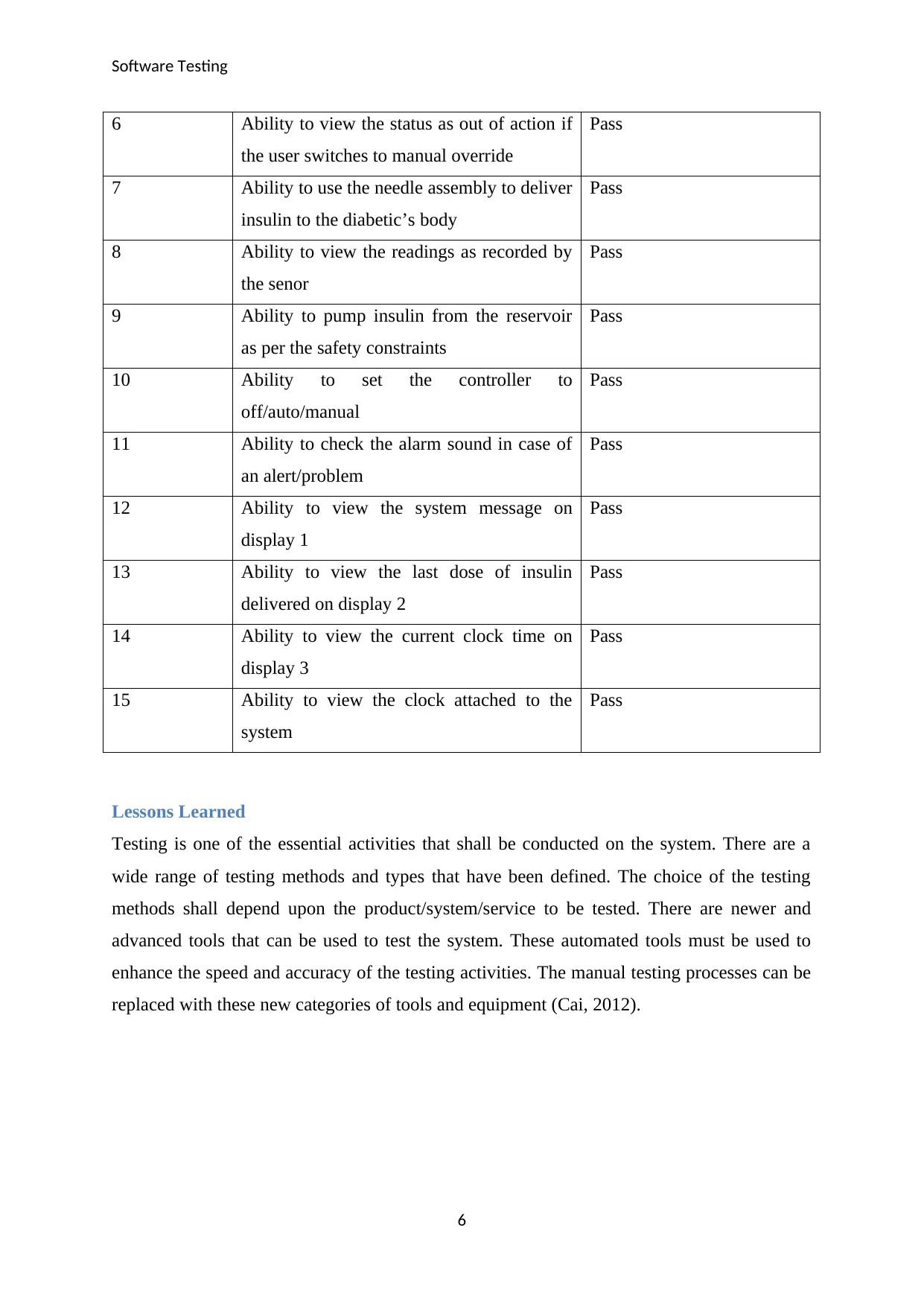
Software Testing
6 Ability to view the status as out of action if
the user switches to manual override
Pass
7 Ability to use the needle assembly to deliver
insulin to the diabetic’s body
Pass
8 Ability to view the readings as recorded by
the senor
Pass
9 Ability to pump insulin from the reservoir
as per the safety constraints
Pass
10 Ability to set the controller to
off/auto/manual
Pass
11 Ability to check the alarm sound in case of
an alert/problem
Pass
12 Ability to view the system message on
display 1
Pass
13 Ability to view the last dose of insulin
delivered on display 2
Pass
14 Ability to view the current clock time on
display 3
Pass
15 Ability to view the clock attached to the
system
Pass
Lessons Learned
Testing is one of the essential activities that shall be conducted on the system. There are a
wide range of testing methods and types that have been defined. The choice of the testing
methods shall depend upon the product/system/service to be tested. There are newer and
advanced tools that can be used to test the system. These automated tools must be used to
enhance the speed and accuracy of the testing activities. The manual testing processes can be
replaced with these new categories of tools and equipment (Cai, 2012).
6
6 Ability to view the status as out of action if
the user switches to manual override
Pass
7 Ability to use the needle assembly to deliver
insulin to the diabetic’s body
Pass
8 Ability to view the readings as recorded by
the senor
Pass
9 Ability to pump insulin from the reservoir
as per the safety constraints
Pass
10 Ability to set the controller to
off/auto/manual
Pass
11 Ability to check the alarm sound in case of
an alert/problem
Pass
12 Ability to view the system message on
display 1
Pass
13 Ability to view the last dose of insulin
delivered on display 2
Pass
14 Ability to view the current clock time on
display 3
Pass
15 Ability to view the clock attached to the
system
Pass
Lessons Learned
Testing is one of the essential activities that shall be conducted on the system. There are a
wide range of testing methods and types that have been defined. The choice of the testing
methods shall depend upon the product/system/service to be tested. There are newer and
advanced tools that can be used to test the system. These automated tools must be used to
enhance the speed and accuracy of the testing activities. The manual testing processes can be
replaced with these new categories of tools and equipment (Cai, 2012).
6
Paraphrase This Document
Need a fresh take? Get an instant paraphrase of this document with our AI Paraphraser
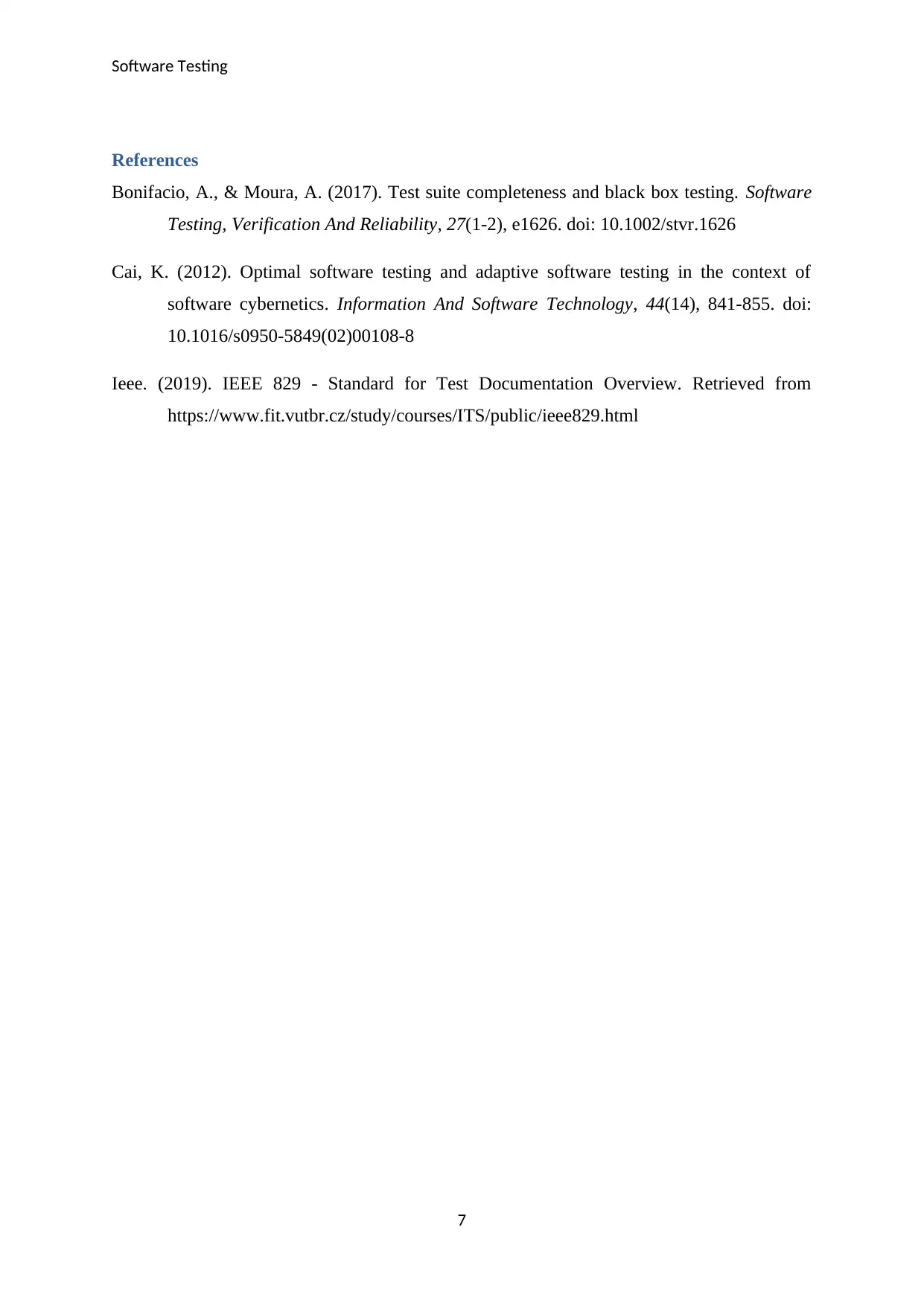
Software Testing
References
Bonifacio, A., & Moura, A. (2017). Test suite completeness and black box testing. Software
Testing, Verification And Reliability, 27(1-2), e1626. doi: 10.1002/stvr.1626
Cai, K. (2012). Optimal software testing and adaptive software testing in the context of
software cybernetics. Information And Software Technology, 44(14), 841-855. doi:
10.1016/s0950-5849(02)00108-8
Ieee. (2019). IEEE 829 - Standard for Test Documentation Overview. Retrieved from
https://www.fit.vutbr.cz/study/courses/ITS/public/ieee829.html
7
References
Bonifacio, A., & Moura, A. (2017). Test suite completeness and black box testing. Software
Testing, Verification And Reliability, 27(1-2), e1626. doi: 10.1002/stvr.1626
Cai, K. (2012). Optimal software testing and adaptive software testing in the context of
software cybernetics. Information And Software Technology, 44(14), 841-855. doi:
10.1016/s0950-5849(02)00108-8
Ieee. (2019). IEEE 829 - Standard for Test Documentation Overview. Retrieved from
https://www.fit.vutbr.cz/study/courses/ITS/public/ieee829.html
7
1 out of 8
Related Documents
Your All-in-One AI-Powered Toolkit for Academic Success.
+13062052269
info@desklib.com
Available 24*7 on WhatsApp / Email
![[object Object]](/_next/static/media/star-bottom.7253800d.svg)
Unlock your academic potential
© 2024 | Zucol Services PVT LTD | All rights reserved.





